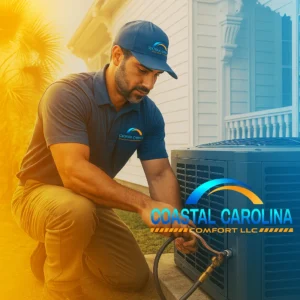Alright, listen up, sugar. Fixin’ that persnickety thermostat AC ain’t harder than wranglin’ a pig in mud. First off, y’all might wanna hit that ‘Reset’ button like it owes you money. Not workin’? Check those batteries – sometimes they’re deader than a doornail. And don’t forget to peek at them wires and connections; they can be looser than a goose in a hen house! A little dustin’ inside wouldn’t hurt none either. If all else fails, consider callin’ a pro – they know their onions when it comes to tricky fixes. Stick around, and you’ll catch on to even more savvy ways to keep cool.
Identifying Common Thermostat Issues
Well, y’all, before we dive deeper than a catfish in a muddy pond, let’s reckon with the fact that there’s a heap of reasons your thermostat might be actin’ more finicky than a hen on a hot griddle.
First off, temperature misreadings can have you sweatin’ like a sinner in church or shiverin’ like a leaf in a tornado, neither of which is much fun, now is it?
Then, there’s them programming glitches – kinda like when your grandma tries to use the remote and ends up callin’ the fire department instead. These little gremlins can throw your whole system outta whack, makin’ your living room feel more like you’re either in Antarctica or the Sahara.
Y’all gotta keep an eye on these pesky issues.
Resetting Your Thermostat
Now, after chucklin’ over those programming gremlins, it’s high time we tackle how to reset your thermostat, a fix simpler than teachin’ a dog to sit. Here’s a quick rundown to get you back to your sweet tea in no time:
- Find that ‘Reset’ Button: It’s usually hidin’ in plain sight. Give it a good press, and let the magic happen.
- Adjust Them Temperature Settings: Get ’em back to where you and your kin feel the most comfortable. No sense in freezin’ or sweatin’ more than necessary.
- Check for Firmware Updates: Sometimes, all your little device needs is a bit of learnin’ with the latest updates.
Checking and Replacing Batteries
Before we dive deeper than a catfish at supper, let’s check those batteries in your thermostat, ’cause sometimes that’s all the fuss is about.
If your AC‘s been actin’ more stubborn than a mule in mud, it might just be thirstin’ for a new power source. Pop open that thermostat like you’re crackin’ a cold one on a hot day. If those batteries look more worn out than your grandpappy’s favorite recliner, it’s time for a swap.
Fresh batteries can bring your AC back to life quicker than you can say ‘room temperature.’ Ain’t no need to call in the cavalry when a simple switcheroo can get you back to feelin’ cool and collected. Remember, y’all, sometimes the solution’s as simple as changing batteries—don’t overcomplicate it.
Inspecting Wiring and Connections
If your AC’s still actin’ lazier than a hound dog in the heat, it’s time to peek at those wirings and connections like you’re huntin’ for hidden treasure. Now, don’t you fret none, here’s how you can do it with a grin:
- Circuit Breaker Safari: First off, mosey on over to your circuit breaker. If it’s tripped, flip ‘er back. It’s like sayin’ ‘Whoa there!’ to a spooked horse.
- Fuse Checks Hoedown: Next up, check those fuses. If they’re blown, it’s like findin’ your mason jar empty at a BBQ. Swap ’em out!
- Tighten Up the Jamboree: Lastly, make sure all connections are tighter than a jar of grandma’s preserves. Loose wires are no good for keepin’ things runnin’ smooth.
Cleaning the Thermostat Interior
Well, y’all, after peekin’ at them wires, it’s time to give that thermostat’s insides a good ol’ tidy up.
You’ll be surprised how much dust gathers in there, like a dust bunny convention!
Now, we’re gonna gently sweep ’em out and put it back together, easier than pie.
Identify Dust Accumulation
Y’all mightn’t believe it, but a hefty bunch of dust hiding inside your thermostat can throw the whole system out of whack. Now, before y’all start thinkin’ it’s some highfalutin problem, let me tell y’all, it’s simpler than fixin’ a plate of biscuits. Here’s how to spot that sneaky dust:
- Temperature Calibration: If your room feels hotter than a hen on a July afternoon, but the thermostat disagrees, dust might be foolin’ your system.
- Room Ventilation: Noticed your room’s stuffier than a crowded dance hall? Dust could be blockin’ them ventilation signals.
- Visual Inspection: Just pop that cover off and peek inside. If it looks like a dust bunny’s paradise, well, there’s your sign.
Gentle Cleaning Techniques
Now that we’ve spotted that pesky dust, it’s high time we roll up our sleeves and give that thermostat interior a good ol’ fashioned cleaning. You see, y’all, dust and grime ain’t just unsightly; they’re downright disrespectful to your quest for humidity control and a life free from the tyranny of UV exposure.
Grab yourself a soft brush or a can of compressed air. Gently, now—like you’re tickling the underbelly of a sleeping cat—brush away the dust. For those stubborn spots, a q-tip dipped in rubbing alcohol will do the trick. Remember, we’re not scrubbing a pot after a chili cook-off; we’re giving our thermostat a spa day. Gentle does it, partner.
After all, we’re aiming for a clean bill of health, not a trip to the repair shop.
Signs of a Faulty AC Thermostat
Reassembling After Care
After givin’ your thermostat’s insides a tender lovin’ clean, it’s time to put her back together like a puzzle at a family reunion. Now, y’all might be wonderin’ what comes next. Well, bless your heart, I’m here to guide you through:
- Lubrication methods: A lil’ dab’ll do ya. Use just enough to get those gears movin’ smooth as molasses, but not so much that it’s slicker than a minnow.
- Tool selection: Get your trustiest screwdriver. No need for fancy gadgets; a good ol’ Phillips or flathead will serve you better than sweet tea on a hot day.
- Patience: Like watchin’ grass grow, don’t rush. Ensure each piece fits snug as a bug in a rug.
Y’all got this. Keep it simple, and she’ll be runnin’ like new.
Adjusting the Anticipator
Well, sugar, if your AC’s actin’ all kinds of wonky, it might just be time to give that anticipator a little nudge. Now, don’t go thinkin’ this is rocket science. The anticipator’s job is kinda like your mama predictin’ you’re gonna be hungry before you even say it. It’s all about anticipatin’ how much coolin’ your space needs to keep the temperature just right.
If your place is hotter than a billy goat in a pepper patch, then your anticipator might need a slight adjustment. Don’t worry, it’s not about performin’ magic or nothin’. Just a little tweak for temperature calibration, and you’ll be chillin’ like a villain. Remember, we ain’t touchin’ thermostat calibration now – that’s a story for another day.
Testing Thermostat Calibration
So, y’all ready to dive into testin’ that thermostat calibration to make sure it ain’t tellin’ tales taller than a cornstalk in July? Here’s how to check if your home’s feelin’ hotter than a billy goat in a pepper patch or colder than a well-digger’s seat due to temperature discrepancies:
- Set it and Forget it: Adjust your thermostat 5 degrees higher or lower than the current room temperature. Wait a few moments to see if there’s a change.
- Check for Drafts: External influences like open windows or drafty doors can fool your thermostat. Make sure it’s not sittin’ near any of them.
- Use a Reliable Thermometer: Compare the thermostat’s readin’ with another thermometer. If they’re singin’ different tunes, y’all might’ve a calibration issue.
Professional Thermostat Replacement
Well, sugar, if y’all have been fiddlin’ with that thermostat more than a cat chasin’ its tail and it’s still actin’ up, it might just be hollerin’ for a professional swap-out.
Let’s talk about them tell-tale signs your thermostat’s on the fritz and how the pros do a switcheroo, smooth as butter.
It’s like gettin’ a fresh haircut; sometimes, you gotta call in the experts to look and feel your best.
Signs of Failure
Y’all might reckon your thermostat’s gone haywire if it’s acting more stubborn than a mule in mud season, refusing to cool your den. When the darn thing starts showing signs of kicking the bucket, here’s what to watch out for:
- Temperature inaccuracies: Y’all set it to chill, but it’s hotter than a billy goat in a pepper patch. Clearly, something’s off.
- Inconsistent cooling: One minute, your place is as cool as a cucumber; the next, it’s like the devil’s living room.
- The silent treatment: It just won’t respond, no matter how sweetly y’all talk to it.
In these cases, it might be time to call in the cavalry for a professional swap-out before you’re stuck frying eggs on your living room floor.
Replacement Process Overview
Decidin’ to get that ornery thermostat replaced professionally means you’re in for a hoot of an adventure, without the fuss of doin’ it yourself. Now, let me walk y’all through it, simple and sweet. Handin’ over the reins to a pro not only saves you a headache but also comes with perks like warranty information. That’s right, no more sweatin’ over a malfunction ’cause the warranty’s got your back.
Then, there’s talkin’ ’bout installation costs. Don’t let the numbers scare ya; consider it an investment in your peace of mind and comfort. Plus, a professional’s touch ensures it’s done right the first time, savin’ you money down the road. So, y’all ready to join the professional thermostat replacement rodeo? It’s a smooth ride, promise.
Frequently Asked Questions
How Can Fluctuations in Household Voltage Affect My Thermostat’s Performance?
Y’all, fluctuations in your home’s voltage can throw your thermostat for a loop, causing it to act all wonky. Voltage stabilizers and guarding against electrical surges can keep it running smoother than a hound’s tooth.
Can a Malfunctioning HVAC System Cause My Thermostat to Appear Broken When It’s Not?
Y’all, 75% of “broken” thermostats ain’t even busted; they’re just victims of a cranky HVAC system. Issues like system compatibility and wiring snafus can make your thermostat act all kinds of funny.
Are There Any Smartphone Apps That Can Help Diagnose Thermostat Problems Before Seeking Professional Help?
Y’all, there’s apps out there with diagnostic tools that’ll talk to your AC like a long-lost cousin. They’ll check if your thermostat’s just playin’ possum or needs a real fixin’, bless its heart.
How Do Seasonal Changes and Humidity Levels Impact the Calibration and Performance of My Thermostat?
Y’all, seasonal changes and humidity can throw your thermostat’s temperature accuracy outta whack faster than a mosquito at a barbecue. Calibration tools are your best pals to ensure it’s measuring right and keepin’ y’all comfy.
Can Installing a Smart Thermostat Help in Reducing Frequent Thermostat Malfunctions and Improve Energy Efficiency?
Ain’t you tired of thermostat fuss? Installing a smart thermostat could be your energy-saving sidekick. Sure, installation costs a pretty penny, but with smart home integration, y’all join a savvy circle. Worth it, right?
Conclusion
Well, y’all, if your thermostat’s actin’ more stubborn than a mule at a square dance, you’ve got some tricks up your sleeve now. Remember, nearly 25% of thermostat problems can be fixed with a simple reset or battery change – ain’t that somethin’?
But if it’s still givin’ you the cold shoulder (or the hot hand), it might be time to call in the AC Repair pros. Don’t let a little tech trouble keep ya from your comfort, darlin’. Keep it cool, or warm, dependin’ on your fancy!


